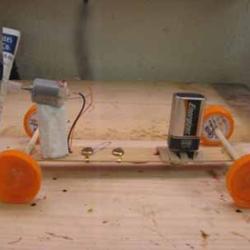Source Institutions
Source Institutions
Add to list Go to activity

In this activity, learners construct cars that are powered by hand-made, electric propellers. Learners construct the base of the car out of a craft stick, use brass tacks and a paper clip to make a switch, and assemble a circuit using wire, a motor, and 9V battery. This project will help learners explore concepts of motion and forces including Newton's Laws of Motion, friction, and acceleration as well as circuits and electricity. [Activity is publicly available through a web crawler capture on Archive.org.]
- Under 5 minutes
- 1 to 2 hours
- $5 - $10 per student
- Ages 8 - 18
- Activity, Lesson/Lesson Plan
- English
Quick Guide
Materials List (per student)
- 1 Craft Stick
- 4 Car wheels (bottle tops, caps)
- 2 Straws
- 2 Skewer sticks
- 1 Motor
- 1 Card stock or playing card for propeller
- 1 Piece of hot glue stick, 1/4 in long
- Material for propeller platform (styrofoam, e.g.)
- Electrical wire
- 2 Brass tacks
- 1 Paper clip
- 9V battery
- 9V battery snaps
- 1 Plastic bottle (optional)
- 1 Bamboo skewer (optional)
- 1 Small piece of paper (optional)
- Scissors
- Rubber bands
- Hot glue gun
- Soldering iron (optional)
- Drill
Subjects
-
Engineering and Technology
-
Engineering
- Electrical Engineering
- Transportation Engineering
-
Engineering
-
Physical Sciences
-
Electricity and Magnetism
- Electric Circuits
-
Motion and Forces
- Momentum and Velocity
- Acceleration
- Newton's Laws
-
Electricity and Magnetism
-
The Nature of Science
-
The Scientific Process
- Conducting Investigations
-
The Scientific Process
-
The Nature of Technology
- The Design Process
Informal Categories
- Toys
- Transportation
Audience
To use this activity, learners need to:
- see
- touch
Learning styles supported:
- Involves hands-on or lab activities
Other
Includes alignment to state and/or national standards:
This resource is part of:
Access Rights:
- Free access
By:
- Watsonville Environmental Science Workshop
Rights:
- All rights reserved, Watsonville Environmental Science Workshop, 2011
